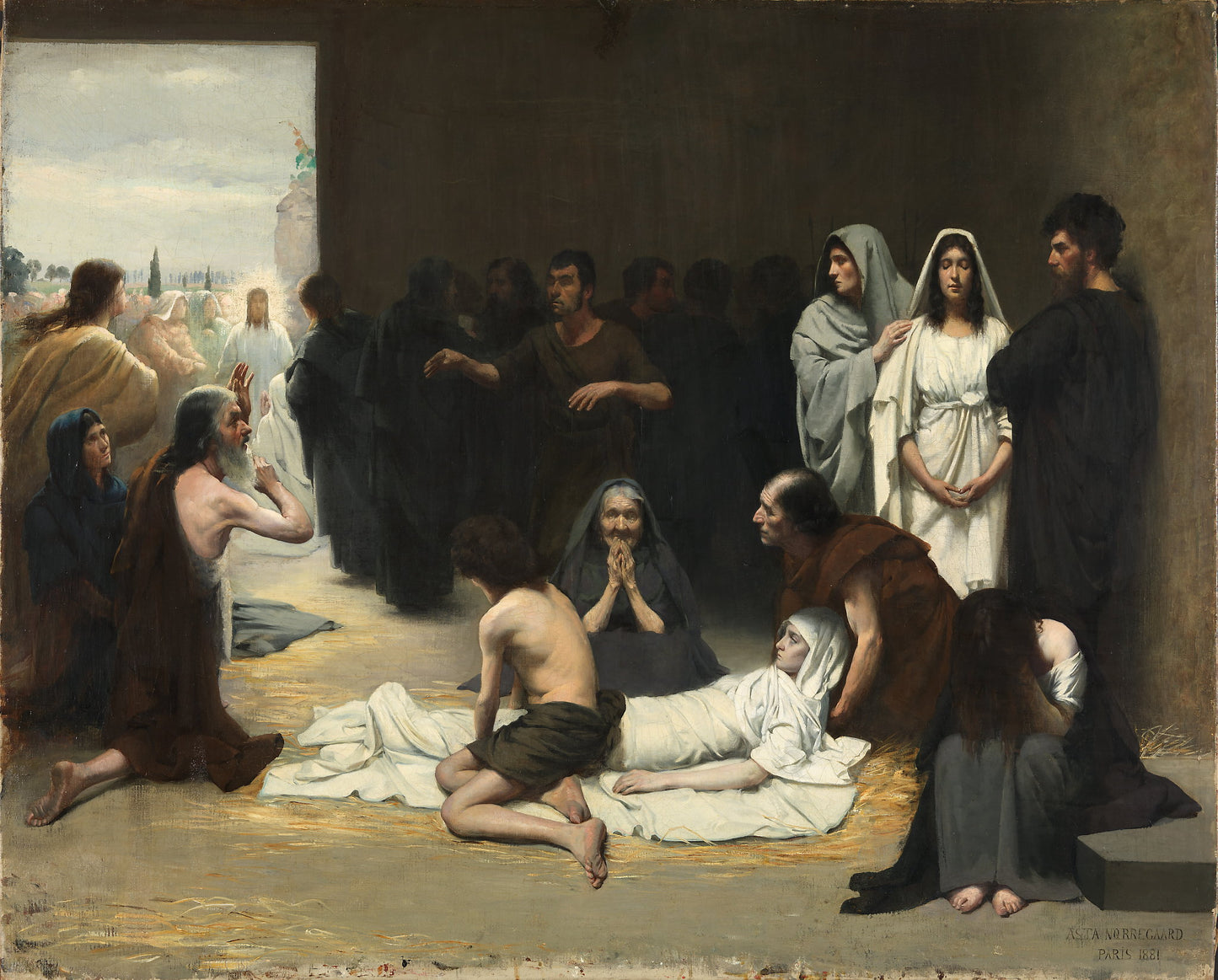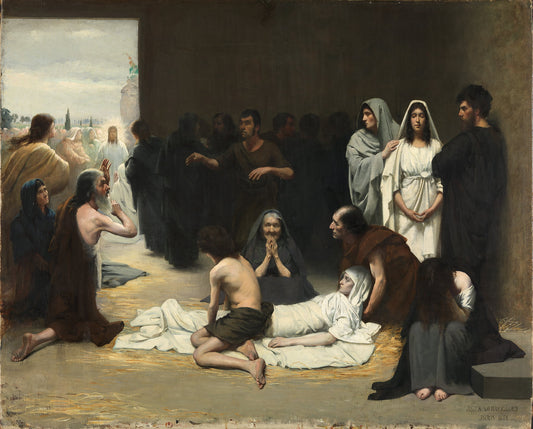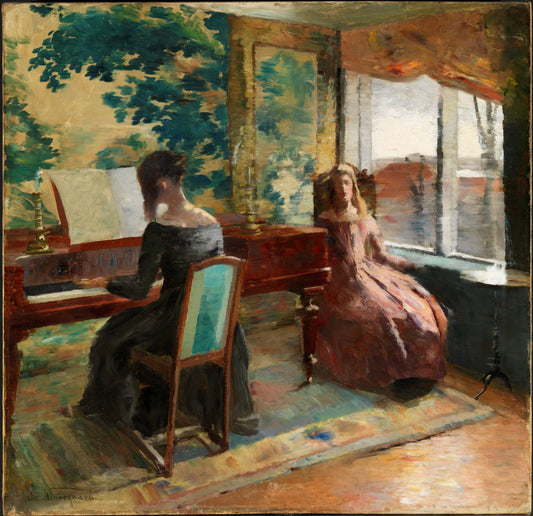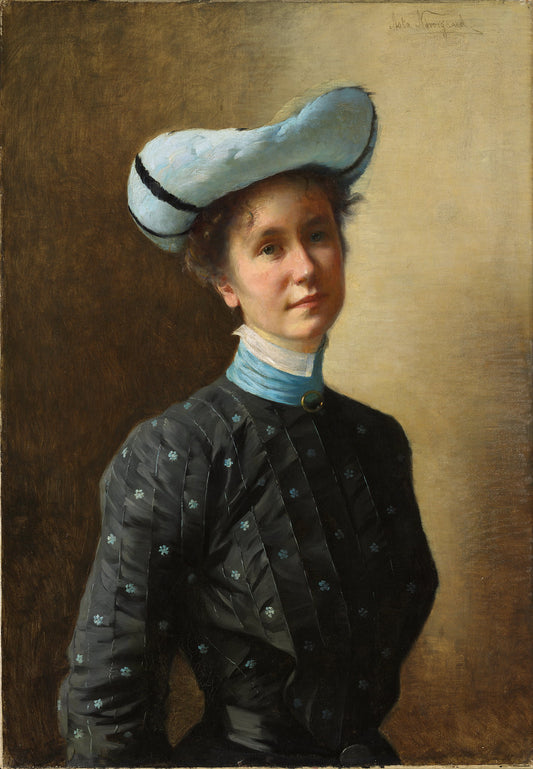Asta Nørregaard
Christ is coming
Christ is coming
Couldn't load pickup availability
Art reproductions with authentic colors and details. Posters are printed on 230g Litho White Matt photo paper with white border and logo. Artprints are printed on 260g Museum Natural Rag 100% cotton paper without white border and logo. Produced to order in our own print lab. From our exclusive collaboration with the National Museum.
About the original:
Nørregaard grew up in an officer's family in Oslo. At the age of 20, she started at Bergslien's painting school. She was a pupil of Eilif Peterssen in Munich in the years 1875–78 and later studied in Paris. It was portraiture that she wanted to specialize in. At the same time, she painted several landscapes and figure compositions. Nørregaard carried out a number of formal portraits on commission.
Portraits of the upper class
It was especially the women in the upper social strata who wanted to be portrayed by Nørregaard, but she often painted both husband and wife in a family. Nørregaard most often portrayed the woman using pastel, while the men were portrayed in oil. If children were to be portrayed, she also often used pastels.
Nørregaard's portraits often give an impression of strong realism. You will probably quickly become convinced that the model looked exactly like this.
A provocative altarpiece
Nørregaard's most prestigious commission was the altarpiece for Gjøvik Church. The church was designed by architect JW Nordan and inaugurated in 1882. The motif of the altarpiece is the consoling Christ, and the composition is dominated by a standing figure of Christ. The altarpiece was painted in Paris. It was not well received when it arrived in Gjøvik in 1883; it was believed that Christ was made too small and insignificant. The result was that Nørregaard had to change the composition and lengthen the figure of Christ. Nørregaard saw this as a defeat, but the congregation in Gjøvik was at least satisfied.
Date: 1881
Other titles: L'Attente de Christ (FRA)
Waiting for Christ (ENG)
Designation: Painting
Material and technique: Oil on canvas
Technique: Oil
Material: Canvas
Dimensions: 93.5 x 115.1 cm
Subject: Visual arts
Classification: 532 - Visual arts
Acquisition: Purchased 1998
Inventory no.: NG.M.04418
Registration level: Single object
Owner and collection: The National Museum of Art, Architecture and Design, Visual Art Collections
Shipping and returns
Shipping and returns
Shipping: We deliver to Scandinavia, the EU, the USA and several other countries. Please contact us if your country is not listed and we will try to arrange delivery.
Delivery time: 2-5 days within Norway, 7 days in Europe, 14 days globally.
Packaging: Our products are made to order and sent rolled in environmentally friendly packaging.
Customs Fees: International orders may be subject to customs fees, which are not included in shipping costs.
Return policy: You can return images within 14 days. See our returns page for more information.
Secure Payment: We never store your payment details. See our privacy policy for details.

See all works
-
Farmer's wife from Normandy
Vendor:Asta NørregaardRegular price From 150,00 NOKRegular priceUnit price per -
Christ is coming
Vendor:Asta NørregaardRegular price From 150,00 NOKRegular priceUnit price per -
Music interior
Vendor:Asta NørregaardRegular price From 150,00 NOKRegular priceUnit price per -
Ingeborg Gade Fric
Vendor:Asta NørregaardRegular price From 150,00 NOKRegular priceUnit price per

Asta Nørregaard
Asta Nørregaard was a Norwegian artist who was considered promising and skilled in Norwegian painting in the 1880s. She was born into a bourgeois family in Christiania, and was orphaned at an early age together with her older sister. She received her first education at Knud Bergslien's painting school for women, and later she continued her education in Munich and Paris.
In Munich she perfected herself in the academic tradition, and in Paris she was influenced by both academic realism and plein air painting. Léon Bonnat was one of her teachers and role models as a portrait painter. Nørregaard lived in Paris until 1885, and in these years portraiture was an important genre in her work. When she returned to Kristiania, she established herself as a genre and portrait painter, and had several prestigious commissions. In the years 1887-1889 she spent time in Italy and France, painting impressionist landscapes and figure paintings. From 1889, portraits became completely dominant in her production, and she painted a total of approx. 300 portraits, most in life size. She received commissions from public officials and other public figures, but it is in the portraits of the country's rich and conservative bourgeoisie that she creates her most interesting images.
According to his own catalogue, Nørregaard painted 116 portraits in the period 1890-1905, of which 70 were in pastel. She achieved her most original artistic success in the portraits of bourgeois women, using soft pastel chalks to bring out a delicate, feminine expression. She was also adept at illusory precious fabrics in refined fashionable costumes and refined decorative backdrops and props.








